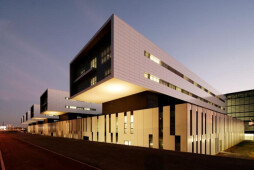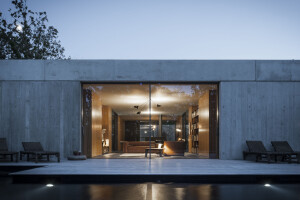The new Hospital Sant Joan de Reus, a hospital centre designed to provide a contemporary response to the hospital programme, reducing energy consumption by 35% compared with the mean consumption of a hospital, shall cover an average of 3,000 people a day and shall become a reference centre for medical oncology and radiotherapy for the whole district of Tarragona. The hospital, which has entailed an investment of around 120 million Euros, has 310 hospitalisation beds and 150 sociosanitary beds, 60 emergency boxes and 10 surgeons; with its 92,073m2 it trebles the size of the old hospital.
The New Hospital Sant Joan de Reus has been jointly designed by the architects' studios Corea & Moran and Pich-Aguilera, specialised in hospital architecture. The building, which starts the expansion of the new technological district Tecnoparc, is considered as a major horizontal unit perforated by patios of light, on which six 2-storey hospitalisation units float. These volumes are connected from west to east by way of a vertebral axis, "la Rambla", which is the space for the public circulation of the hospital centre.
Functional Organisation
As regards the circulatory structure, the architects opted for a clarity of circuits to avoid circulation interferences between health staff and the public and also to facilitate hygiene control. In terms of spatial organisation, it was decided to organise the space horizontally in line with relation and dependence criteria; and vertically in line with the most public to the most restricted. In this way, the ground floor is of a public nature and if you go up to the hospitalisation storeys the character is more restricted, or if you go down to storeys -1 and -2 access is even more restricted.
Floor +1 y +2: Hospitalisation
Floor 0: Outpatient appointments, cafeteria, rehabilitation, sports medicine, drug addiction
Floor -1: Emergencies, operating ward, laboratories, intensive medicine, special tests area
Floor -2: Radiotherapy, oncology day hospital, maintenance and storage
Minimisation of the Landscaping Impact
To reduce as far as possible the landscaping impact, the architects undertook different actions:
-Structure of the building horizontally and inclination of the facade to minimise the visual impact with the environment.
-Orientation of the building in such a way that the inclined façade with pavilions in organic forms is opposite the avenue and this is what the pedestrians perceive and, by contrast, the sequence of the 6 floating volumes are opposite the freeway.
-Inclusion of large green areas on the terraces not only minimises the landscaping impact, but also improves patient comfort as a large garden space can be seen from all the rooms. What's more, from the hospitalisation units you can access 3 of these terraces which are used as gardened squares from which patients can walk in the fresh air.
-Making the most of the excavation land from the same site, engendering a consequent reduction in waste transport and minimisation.
Sustainability and Energy Saving
The architects have designed a building which is integrated into the environment not only from a landscaping but also from a climatic perspective. The New Hospital de Reus has been designed as a body capable of minimising its energy needs. This is why the building has been designed as a porous volume capable of filtering inside the natural contributions of its surroundings: light, air flows, hygrometric level...
1. Efficient Construction Systems integrated into the Project
-Green Roofs. The inclusion of large green areas in the covers of the building, proposing a new concept of urban "naturalisation", aids the recovery of the natural surroundings enveloping the building. What's more, it promotes the environment as it retains the pollution particles and the air is purified, generating a favourable microclimate in the patios which improves thermodynamics.
-Ventilated facade which eliminates thermal bridges and a chamber is created which optimises the thermal performance of the building in our climate.
-Industrialised concrete panels and other mass concrete solutions which augment insulation and thermal inertia and improve soundproofing.
2. Water Heating and Energy Saving Systems
-Solar Photovoltaic Energy at the main façade with the production of electrical energy.
-Rainwater and sewage Separation Systems which are reused for watering the gardens and facilitating their subsequent treatment.
-Flow limiting taps which save water.
-Avoid excessive thermal gains. In this way the ventilated façade systems combine with the arrangement of the water and vegetal substrate of the roof and an apparent thermal solar panel system capable of evacuating solar heating.
3. Climatisation Energy Saving Systems
-Heat pumps with 4 tubes instead of boilers, reducing combustion emissions and producing energetically efficient comfort.
-Free-cooling and recovery of the energy of the extraction air, producing energetically efficient comfort.
-Radiant false ceiling cooling/heating in the hospitalisation rooms which improve patient comfort, consume less than conventional air climatisation and avoids the use of ventilation conduits, a source for the easy transmission of germs.
4. Lighting Energy Saving Systems
-Natural Light. The main reason behind the horizontal layout of the building is the arrangement of patios and skylights which allow the whole working, appointment and hospitalisation space to have natural light, in addition to the possibility of natural ventilation in those seasons when our climate allows us to avoid using heating or air-conditioning.
-Use of fluorescent luminaires equipped with high-performance electronic reactances which produce savings in consumption.
Lighting
1. Lighting in Hospitalisation Rooms - LAMP SOLUTION: CLINIC
Under the premises of functionality and efficiency, Corea & Moran have opted to light up the hospitalization rooms with CLINIC luminaire. The more pleasant the surroundings, the faster patients recover. It is therefore very important for the lighting of hospital rooms to be suitable. Direct lighting causes glare, visual fatigue and stress; whereas indirect lighting prevents glare and creates more comfortable contrasts. The light fixtures used in such rooms must be designed with a neutral, unaggressive appearance while, at the same time, being functional. The lighting system used, being undoubtedly the most complete, is the headboard system:
-Direct lighting: the patient must not be exposed to a luminance of over 750 cd/m2 and the lighting must have a direct glare control.
-Indirect lighting: 100 lux on the floor and 200 lux on walls and ceiling.
-Reading light: 300 lux. Must be accessible and easy to control.
-Examination and/or treatment lighting: 800-1000 lux minimum.
-Night lights: 5 lux.
-Light sources should have warm color temperatures.
-The lighting should be dimmable, giving greater comfort to the patient while helping to save energy.
-It is important to make use of natural light.
To meet most of the aforementioned requirements, the new range of CLINIC headboards, specifically designed for hospitals, elderly people's homes, clinics and health centres, is characterized by its neutral lines and timeless, minimalist design, making the light fixture itself "disappear" from the room and giving the lead role to the light. Made from white lacquered extruded aluminium, it provides direct and/or indirect lighting, and can be customized by choosing the light source and adding the necessary mechanisms (switch, telephone socket, call button, surveillance light, etc.). For the Hospital de Sant Joan de Reusa a special CLINIC luminaire has been designed with three gas sockets built in, mechanisms and sources of light T5-24W (direct lighting) and T5-54W (indirect lighting).
2. Interior Lighting of Halls and Exterior Lighting of Façade - LAMP SOLUTION: PROA
For lighting of the hall, better known as "La Rambla", as well as the exterior lighting of the façade, the architects have gone for the PROA luminaire by LAMP. Made of injected aluminium, lacquered in grey texturised polyester with an IP65 protection index making it very resistant to bad weather, this luminaire is ideal for lighting up façades, spaces of great height and domed ceilings. This Project made use of 35 direct radiation models with asymmetric optics for HIT-DE 150W lamps and two power level equipment which allows a reduction in lighting levels at night.
3. Exterior Lighting Avenida - LAMP SOLUTION: B-SIDE LED
As regards the Exterior Lighting of the hospital centre, the architects opted to light up each exterior space with: "The Right Light". Specifically designed for LED light sources which allow low consumption and minimum maintenance thanks to the 50,000 hours of working life of the LED, the architects opted to light up the Avenue and the access areas of the façade with 200 B-SIDE LED 2'4W, 135mm high bollards. Made of injected and extruded aluminium, lacquered in grey texturised polyester, with corrosion-proofing Alodine 1200 at their base and with protection indices IP65 and IK10, B-SIDE LED is an excellent vandal-proof solution for lighting up public parks, gardens and different urban areas. What's more, it serves as a signpost marking thanks to its self lighting, thus becoming a structuring element of the space.
4. Exterior Lighting Ring Roads - LAMP SOLUTION: SHOT
By contrast, owing to their technical performance and sturdy design, 14 SHOT 380 projectors with spot optics for HIT 150W lamps, IP65 and IK09 were selected for lighting up the 6 floating volumes at the back of the building. Made of injected aluminium, lacquered in grey texturised polyester, their main body incorporates cooling fins as well as a hinged cover with a dual seal to facilitate installation and maintenance.
5. Exterior Lighting Car Park - LAMP SOLUTION: MINI PROA ROAD SYSTEM
Finally, it was decided to opt for the MINI PROA ROAD SYSTEM to light up the car park for health staff. 12 Mini Proas were chosen for this Project with asymmetric optics for a 70W HIT/HST lamp with IP65 and two power level equipment, installed with a final double arm cut into six 6 m high troncoconic columns.







































































